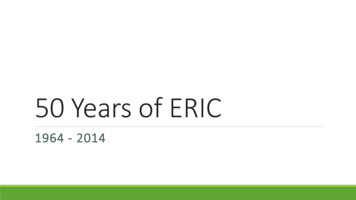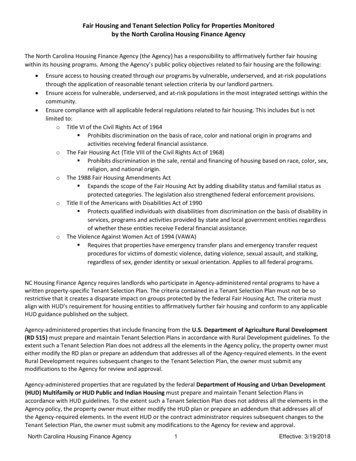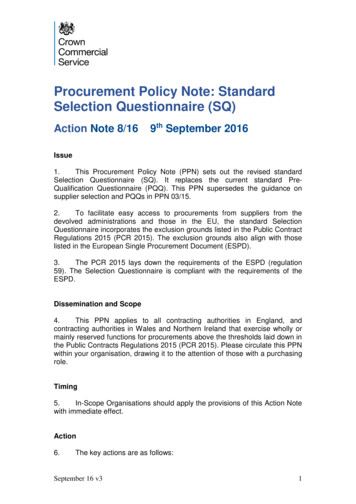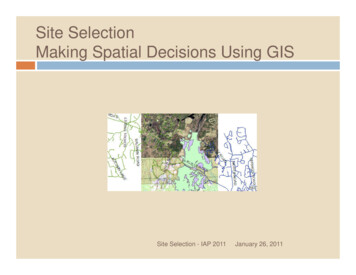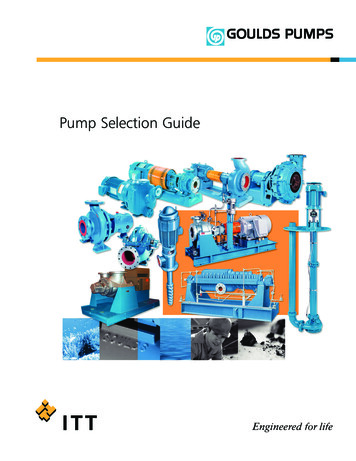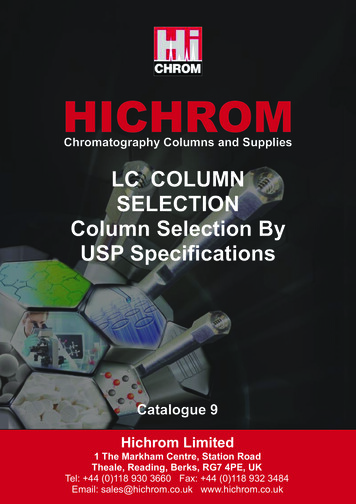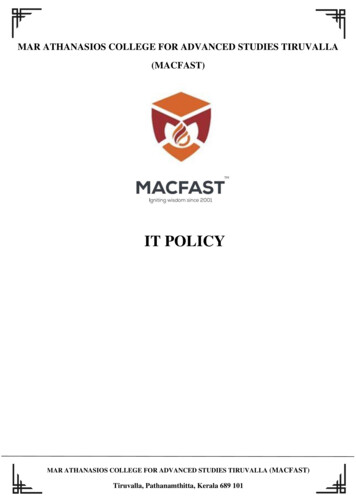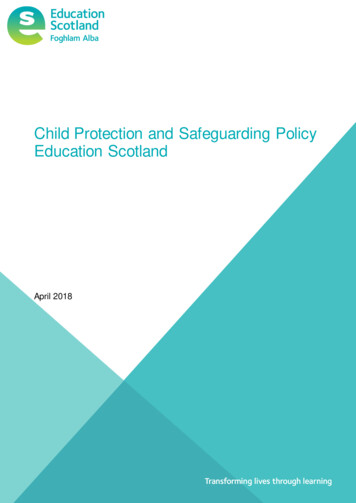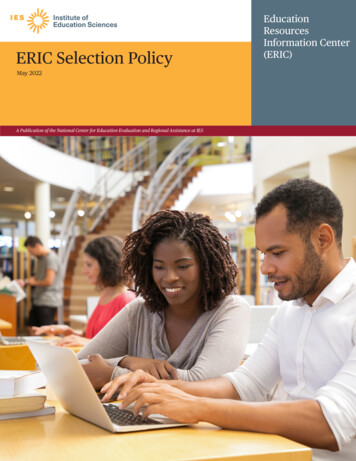
Transcription
ERIC Selection PolicyMay 2022A Publication of the National Center for Education Evaluation and Regional Assistance at IESEducationResourcesInformation Center(ERIC)
ERIC Selection PolicyMay 2022StaffFern FrustiDave BradyNancy CawleyApplied Engineering Management CorporationJudy BeckZimmerman Associates, Inc.Project OfficersErin PollardKaren TateJonathan JacobsonInstitute of Education SciencesERIC Selection Policy (May 2022)i
This report was prepared for the National Center for Education Evaluation and RegionalAssistance, Institute of Education Sciences, under the Education Resources InformationCenter contract to Applied Engineering Management Corporation (Contract 91990019F0399).U.S. Department of EducationMiguel A. Cardona, SecretaryInstitute of Education SciencesMark Schneider, DirectorNational Center for Education Evaluation and Regional AssistanceMatthew Soldner, CommissionerElizabeth Eisner, Associate Commissioner of Knowledge UseThis report is in the public domain. Although permission to reprint this publication is notnecessary, the citation should be as follows:Education Resources Information Center (ERIC) (2022). ERIC Selection Policy. U.S. Departmentof Education. Washington, DC: National Center for Education Evaluation and RegionalAssistance (NCEE). Retrieved from https://eric.ed.gov.This report is available on the ERIC website at https://eric.ed.gov.Alternate FormatsThe Alternate Format Center (AFC) produces documents in specific alternate formats, suchas braille, large print, and electronic format, for employees and members of the public withdisabilities. These documents may include agendas, correspondence, course materials,regulations, and materials for public distribution.Contact the AFC for submission guidelines and turnaround times. Hours of operation areMonday through Friday, 8:00 a.m. until 4:00 p.m., Eastern Time. For information, contact theAFC, Tena Witherspoon, Tena.Witherspoon@ed.gov, (202) 260-0818, or Tracey Flythe, Tracey.Flythe@ed.gov, (202) 260-0852.ERIC Selection Policy (May 2022)ii
ContentsIntroduction Mission Statement Statement of Purpose Collection Development Goals Selection Standard and Criteria 22223Approved Sources of Material 6Periodic Review of the Selection Policy Preservation Policy Online Submission System 889Types of Materials Indexed in ERIC Types of Materials Not Indexed in ERIC Appendix A: ERIC Topic Areas 101314Standard: Directly Related to One or More of the Topics in the Field of Education Criteria: Quality Criteria: Peer Review Criteria: Language Criteria: Material Format Criteria: Publisher Evaluation Criteria: Content Maturity/Currency Criteria: Full Text Access Source Review and Approval Process Inclusion of Materials From Approved Sources Other Requirements 33445556678Copyright and Full-Text Display for Online Submissions Individuals Eligible to Submit Materials Other Online Submission Information 999ERIC Selection Policy (May 2022)1
IntroductionThe Education Resources Information Center (ERIC) is an online bibliographic and full-textdigital library of education research, including journal articles and non-journal materials.ERIC is a program administered by the National Center for Education Evaluation and Regional Assistance of the Institute of Education Sciences (IES) at the U.S. Department of Education(the Department).Mission StatementERIC’s mission is to select, index, and make quality education research widely availableand searchable through a user-friendly website. This supports the mission of IES to providescientific evidence on which to ground education practice and policy and to share thisinformation in formats that are useful and accessible to educators, parents, policymakers,researchers, and the public.Statement of PurposeThis document states broad collection goals and defines the standard and criteria requiredof approved sources and individual materials in the ERIC digital library. The purpose of thisselection policy is to ensure consistency in ERIC’s approach to reviewing and selecting sourcesand individual items and clearly communicate ERIC’s processes and policies to staff, users,publishers, and individual submitters of material.Collection Development GoalsERIC’s collection development is supported by five overarching goals: Assure each approved sourceResearch is defined as original presentations of empiricalproduces education research andand/or data analyses, literature reviews or summaries of afield, methodological works, presentations or critiques ofis relevant to one or more of thetheories, or logic models that can guide practice.topic areas in the IES authorizinglegislation, Section 172(a) 3 of PublicRigorous is defined as content that has gone through anLaw 107-279, Education Scienceseditorial or peer-review process and presents a methodReform Act of 2002. See Appendixand approach that are reasonable and sound.A for brief descriptions of ERIC’s 16Relevant is defined as materials with a demonstrabletopic areas.bearing on the field of education and the work of the fourIncrease the number of peercenters at IES: National Center for Education Evaluationreviewed, full-text sourcesand Regional Assistance, National Center for EducationResearch, National Center for Education Statistics, andindexed in ERIC.National Center for Special Education Research.Increase the number of rigorousand relevant non-peer-reviewed, full-text materials from non-journal sources suchas think tanks, institutional repositories, research organizations, state and districtresearch offices, and technical assistance providers.Limit citation-only indexing to those materials that, while not available full text inERIC, are among the most rigorous and relevant to contemporary issues in educationpolicy or practice.Prioritize sources with content including participants in the United States.ERIC Selection Policy (May 2022)2
Selection Standard and CriteriaThe selection standard and criteria as described in this document are applied at the sourceand/or the item level to build the ERIC collection. No material or bibliographic recordspreviously published in ERIC will be removed as a result of this or future updates to theERIC Selection Policy.Standard: Directly Related to One or More of the Topics in the Field of EducationAll materials indexed in ERIC must meet the selection standard of being directly related to thefield of education as described by one or more of the topic areas in the IES authorizing legislation.The scope of the ERIC collection includes education research on closing the achievement gap,educational practices that improve academic achievement and promote learning, and the 16topic areas as briefly described in Appendix A: Adult, career, and vocational educationAssessment and evaluationCommunity collegesCounseling and student servicesDisabilities and gifted educationEducational managementElementary and early childhoodeducationHigher educationInformation and technology Languages and linguisticsReading, English, andcommunicationsRural education and small schoolsScience, mathematics, andenvironmental educationSocial studies and social scienceeducationTeaching and teacher educationUrban educationVisit the ERIC Topic Area page for lists of the currently indexed journal and non-journalsources by the ERIC topic area that most closely aligns with the scope of the source.Criteria: QualityMaterials indexed in ERIC must meet the following quality criteria: Completeness: The material must be complete; usable as it is presented;contain sufficient content or labeling for items such as data tables, graphics, andbibliographies; and in a final form. Working papers and prepublished versions maybe accepted, provided they are complete, free of track changes or edits, and are notwatermarked as drafts.Integrity: The material from a source in which ERIC has an agreement to index itscontent must include its source name. The author’s name must be on a documentsubmitted to the ERIC online submission system.Substantive Merit: The material must address the scope area(s) in a professionaland/or definitive way.Utility/Importance: The material must be relevant to current issues in educationand be of interest to the broad education community.Education Research: Materials are original presentations of education data and/orempirical analysis, literature reviews or summaries of a field, methodological works,presentations or critiques of theories, or logic models that can guide practice.ERIC Selection Policy (May 2022)3
Criteria: Peer ReviewERIC accepts peer-reviewed and non-peer-reviewed material for indexing. Records are markedas peer reviewed if the source has demonstrated that the journal or non-journal content hasgone through an acceptable peer-review process.ERIC recognizes the following types of peer review Blind or Anonymous Peer Review: Content is reviewed by external reviewers and theauthor’s identity is unknown to the reviewer. A double-blind peer-review process iswhere both the reviewer and the author remain anonymous throughout the process.Expert Peer Review: Content is reviewed by internal or external reviewers, and theauthor’s identity may or may not be known to the reviewer.A peer-review process employing at least two reviewers with scholarly affiliation is preferred.Editorial reviews are not recognized by ERIC as an accepted type of peer review. A scholarlypeer-review process often takes several rounds and revisions.Content published by sources under agreementERIC will review the publisher’s website or its content to evaluate its peer-review policiesand processes. If the peer-review process meets the definition stated above, the ERIC recordswill have the peer-reviewed indicator. If not, the publisher may submit an application formdocumenting its process. The review process is the same for journal and non-journal sources. For journals, the peer-review designation is determined at the journal level andapplied to all ERIC records created for the source.For non-journal sources, the peer-review designation may be assigned to ERIC recordsfor all their content, for a specific series, or to a select type of publication.Content acquired from individuals via the ERIC online submission systemA U.S. Department of Education federal grantee or contractor may indicate duringsubmission that the content has been peer reviewed. No further evidence of a peer-reviewprocess is required.Those who do not have a grant or contract with the U.S. Department of Education can havetheir content marked as peer reviewed on the ERIC record if evidence is provided of a blind orexpert peer-review process. This may be demonstrated by an explanation of the peer-reviewprocess on the front matter of the document. Alternatively, the author may submit a URL tothe peer-review process explained on the publisher or conference website. A statement by theauthor that the content is peer reviewed is not sufficient.Criteria: LanguageMaterials indexed in ERIC must be written in English, or a translation of the full text must beavailable in English. The content presented in materials must conform to standards of Englishgrammar and understandability. Material written in a language other than English may beaccepted for indexing if it is published by a U.S. federal agency or grantee and accompaniedby an abstract and bibliographic citation in English.ERIC Selection Policy (May 2022)4
For sources originating in a country where English is not the official language, the source’swebsite must be available in English and the publisher must provide or make available the fulltext to ERIC for indexing to verify the language of the content. The source does not need to giveERIC permission to display the full text. The articles must continue to be available in English.Criteria: Material FormatThe publisher of an approved source must provide or make available the materials in anacceptable format to create the ERIC records. Electronic formats include PDF, ERIC XMLformat, or another acceptable XML format. Scanned image files saved as a PDF or contentonly available in an interactive online format cannot be accepted for indexing. Onlinesubmissions from individuals must be provided in a readable, digitally created PDF.Criteria: Publisher EvaluationJournal sources are also subject to a review of policies and processes, using thefollowing guidelines: Transparent communication and implementation of policies, procedures, standards,and fees for article submissions.Free of charges of unethical practices, plagiarism, editorial or publisher misconduct,or copyright disputes; rarely needs to retract an article.Selectivity, as indicated by acceptance rates or the number of articles published per year;publishes only content that reflects the aim and scope statement and the source name.Research is clearly presented, and manuscripts are free of typographical errors.Scholarly affiliation of editors and review-board members.Complete, accurate, and up-to-date information on the website, including sponsorship,abstracting and indexing services, address, and editorial or review boards.Website is fully functional and accessible without error messages.Preference for inclusion in ERIC may be given to a source with sponsorship by a professionalsociety or organization (national or international), or a federal or state government agency.The following may also be considered when evaluating non-journal sources: history of the organization;governance structure, composition, and credentials of the governing body;membership of the organization, in size and credentials;organizational activities and associated review policies for products and services; andpublication programs and associated editorial policies.Political affiliation is not considered during source or material selection.Criteria: Content Maturity/CurrencySources should have a minimum of a 3-year history of quality scholarly publishing focused oneducation research before applying for review to be indexed in ERIC.A regularly indexed source is expected to publish on a timely basis, indicate the most currentmaterial on the source’s website, and provide the current material to ERIC for indexing as it ispublished. If a source has not published for more than 18 months or does not routinely makecontent available for indexing, it may be a reason for ERIC to discontinue indexing the source.ERIC Selection Policy (May 2022)5
Criteria: Full Text AccessAccess for users to the full text of content indexed in ERIC is considered during the review ofsources. If a journal is not open access on the publisher’s website, we determine the numberof libraries subscribing to the journal to ensure that members of the public would be able toaccess the full text though their local or institutional library. Member-only content may notmeet this selection criteria.Approved Sources of MaterialThe process to review sources and interact with publishers is outlined below. Currentlyindexed sources are listed on the Journal List and the Non-Journal List.Source Review and Approval ProcessERIC periodically performs a collection analysis of the currently indexed sources to determinethe coverage of the ERIC topic areas, as described in Appendix A.Twice a year, in the fall and in the spring, ERIC considers additional sources of research fromacross the field of education. Potential sources are nominated by subject matter experts,users, publishers, or they are identified by surveying resource databases. Preference is givento sources funded by the Department and sources meeting collection development goals.Source nominations may be sent via email to ERICRequests@ed.gov.New Sources: The process to consider and select new sources includes the following steps:1. Review the most current collection analysis.2. Identify underserved areas in ERIC and emerging trends in education.3. Survey resources to identify potential sources and gathering suggested sourcesto review.4. Collect background information and reviewing content to determine adherence to theselection policy standard and criteria.5. Prioritize suggested sources according to the collection goals.6. Submit source recommendations to the Department for approval.The following steps happen after the review of potential sources: ERIC establishes agreements with publishers of selected sources granting permissionto index the content in ERIC. Publishers may also grant permission to display the fulltext of the material in ERIC immediately or after a publisher-defined embargo.Publishers of sources not selected are eligible to reapply to be reviewed 2 years (24months) after the review is completed. Sources may not be reviewed more than threetimes in a 10-year period.Sources not containing education research or that are not in English may not reapplyunless the scope or language of the journal has changed and the changes have been ineffect for 2 years (24 months).ERIC Selection Policy (May 2022)6
Currently Indexed Sources: The review of the current collection includes the following steps:1. Identify sources that may no longer meet the standard and criteria of the selectionpolicy or have ceased, closed, or stopped providing content.2. Submit source recommendations to the Department to no longer indexthe source(s).3. Notify the publisher. If a source is discontinued, records or content already in ERICwill not be removed.Inclusion of Materials From Approved SourcesThe publisher of an approved source must hold copyright to the material or be an authorizedagent acting on behalf of the copyright holder and sign an agreement allowing ERIC to indexthe material. ERIC indexes material copyrighted by multiple sources when any one sourcegrants permission.During the source review and approval process, ERIC’s coverage of the source’s contentis determined.Journal SourcesThree to five current issues are examined during the source review process to assign coverage.Sources are indexed comprehensively or selectively: Comprehensively indexed journals include 80 percent or more education researcharticles in every issue; ERIC creates a bibliographic record for all articles in everyacquired issue.Selectively indexed journals include 50-79 percent education research articles inevery issue and are critical to topic area coverage; ERIC applies a manual article-byarticle selection process and indexes only substantive education research articles.Comprehensive coverage is not guaranteed, and a journal may be switched between beingcomprehensively or selectively indexed at any time. If the percentage of education researchdrops below 50 percent, a review will be conducted to determine if ERIC should continueindexing the journal.Non-Journal SourcesMost sources associated with the Department are indexed comprehensively; all other nonjournal sources are indexed selectively. The comprehensively indexed non-journal sources include IES and its offices:National Assessment of Educational Progress, the National Center for EducationEvaluation and Regional Assistance, the National Center for Education Research, theNational Center for Special Education Research, the What Works Clearinghouse, theRegional Educational Laboratories, National Forum on Education Statistics, NationalPostsecondary Education Cooperative, and others as directed by the National Centerfor Education Evaluation and Regional Assistance Commissioner or IES director. Selectively indexed non-journal sources include other federal departments; stateor local agencies; university-affiliated programs; policy organizations, research andnonprofit organizations; state and district research offices; federal technical assistanceERIC Selection Policy (May 2022)7
providers; professional associations; international or foreign organizations; bookpublishers; commercial publishers; institutional repositories; and user submissions.ERIC applies a manual document review and selection process and indexes only thedocuments that conform to the standard and criteria outlined in this document.Other RequirementsAfter a source is approved, attention is given to operational requirements: Source Identification: The source name must be explicitly placed on the content, ora statement of ownership must be in the text of the document.Source Changes: If a source name changes or it is acquired by a new publisher, ERICmay review the source again when new content is published. If a source is acquiredby a new publisher, ERIC must establish a new agreement to continue indexing.Content Delivery: A publisher will put forth reasonable effort to provide or makeavailable new content within 30 days of publication. Acceptable delivery methodsinclude SFTP, emailing files to ERIC@ed.gov, or granting permission for ERIC todownload content from the publisher.Ongoing Standard and Criteria Requirement: If an approved source no longermeets the standard and criteria outlined in this policy, or is not providing currentcontent, it may be discontinued.Periodic Review of the Selection PolicyOn a periodic basis, ERIC will review this selection policy and recommend updates ormodifications. ERIC may post suggested changes to the website or host a webinar to share keyupdates. Following any changes, a review of currently approved sources may be conducted todetermine their continuation.Preservation PolicyAs a historic repository of education research, ERIC retains bibliographic records indefinitelyand in perpetuity. As the sponsor of ERIC, IES will only delete a record or full-text contentin exceptional circumstances (e.g., publisher requests the removal of a retracted article;copyright holder validation of plagiarism; or personally identifiable information is foundin the full text). ERIC will not adjudicate or arbitrate any copyright dispute, nor will ERICinvestigate allegations about the content in any article or document indexed in ERIC.The content of publications in ERIC may not reflect the views or policies of IES or the U.S.Department of Education, including language or terminology, viewpoints, or framing ofresearch questions, but these are not grounds for the removal of an ERIC record or full text.No material or bibliographic record published in ERIC will be removed as a result of this orfuture updates to the ERIC selection policy.ERIC Selection Policy (May 2022)8
Online Submission SystemIn addition to material published by an approved journal or non-journal source, eligibleindividuals may submit content for review via the ERIC online submission system at https://eric.ed.gov/submit/. Eligibility is outlined below. The material must meet the standard ofdirect relevance to one or more topics of the field of education and the selection criteria asdescribed above in this document.Copyright and Full-Text Display for Online Submissions All submitters retain copyright.By submitting your materials, you are providing IES a royalty-free, perpetual, andirrevocable license to index and display the full-text of the materials to the publicat https://eric.ed.gov. This license is subject only to the narrow exceptions set forth inthe Preservation Policy section of the ERIC Selection Policy.Individuals Eligible to Submit MaterialsGrantee SubmissionsIES requires its grantees and contractors to submit their peer-reviewed research publicationsto ERIC. The grantees must submit their final manuscript to ERIC within 12 months of thejournal publisher’s official date of publication.If an IES grantee or contractor work is published after January 1, 2020, in a sourcethat has agreed to submit the work on behalf of the grantee or contractor, the authoris not required to also submit the work to ERIC. The list of participating sources is athttps://eric.ed.gov/?pajournals.The full text will display in ERIC 12 months from the publication or completion date.The ERIC records will include the indicator of Grantee Submission.Online SubmissionsNon-journal content may be submitted by an authorized representative of an organization,agency, association, commission, project, program, or another similar group, or by an author.Journal articles may only be submitted if the source is not under agreement with ERIC andmust be submitted by the author. Content with multiple authors is accepted when one author submits the content.The full text will display immediately in ERIC.The ERIC records will include the indicator of Online Submission.Other Online Submission InformationEvery submitted item is manually reviewed by ERIC staff. The submission must conform tothe selection standard and criteria and individual submitter requirements to be added tothe collection. The submission must be submitted in PDF format and be complete, final, andcorrectly marked. Include the full text of all pages of a document or article, attachments or tables, andan abstract.ERIC Selection Policy (May 2022)9
Markings include a title of the article or document; author(s) name; date ofpublication, presentation or completion; and conference information, if it applies.Peer-review assignment is explained in the section Criteria: Peer Review above.An ERIC record (with an ED number) is added to the collection.Note: Click Submit or FAQ on the ERIC website for complete requirements and guidelines.Types of Materials Indexed in ERICERIC indexes journal articles, books, and grey literature materials meetingthe standard and criteria as outlinedin this document.Definition of grey literature from the 12th InternationalThe ERIC grey literature collection rangesfrom information briefs to substantive,rigorously researched and revieweddocuments, conference papers, and policyreports. The material originates primarilyfrom selected non-journal sources butmay also be submitted by individual usersof the ERIC online submission system.Conference on Grey Literature at Prague, December 2010:“Grey literature stands for manifold document types produced on all levels of government, academics, business andindustry in print and electronic formats that are protected byintellectual property rights, of sufficient quality to be collected and preserved by library holdings or institutional repositories, but not controlled by commercial publishers i.e., wherepublishing is not the primary activity of the producing body.”The following table provides examples ofthe types of materials considered for inclusionin ERIC.Types of onference or meetingpublicationsBrief DescriptionSummaries or detailed examinations of educationpolicy; includes policy papers analyzing judicial rulingsand historical retrospectives examining the impact ofspecific rulings on education over time.Lists of publications and/or reference information. An idealdocument will be an annotated bibliography with a statedpurpose and methodology, or a similar introduction.Fully developed publications or reference materials; bookchapters may be selected for indexing.Brief publications focused on education-related topics; notmarketing materials.Documents containing statements summarizing themain points of an issue; may offer a proposed solution orrecommendation.Substantive summaries of meetings convened to examinetopic-specific or thematic issues in education; collected works;transcripts or summaries of conference proceedings; fullydeveloped research or scholarly papers or posters presentedat a conference; and selected conference presentations,including keynote speeches; not conference programs.ERIC Selection Policy (May 2022)10
Types of MaterialCongressional orlegislative publicationsBrief DescriptionPublications of the United States Congress or statelegislatures regarding education-related topics;administrative documents related to school districts,legislation, legislative hearings and testimonies;congressional documents, executive orders, Federal Registerpronouncements, state legislature documents, laws,summaries of legislative action, etc., related to education.Data profilesReview of source data or overviews focusing oneducation and related variables; includes demographicprofiles, composite reports, strategic plans, and reportson school year and instructional time; enrollmentstatistical reports are accepted with explanatory text.Dissertations/thesesPh.D., Ed.D., or Ed.L.D. are preferred.Federal, state, or localReports of public instruction on topics such as high schoolagency reportsdropout rates, high school completion rates, studentteacher ratios, free and reduced-price meal participation,consolidated state performance reports, state or districtreport cards or progress reports, education personneland salary summaries, and federal or state educationalaccomplishments.Finance informationEvaluations, reports, or studies of the financial issuesrelated to educational programs, institutions, systems, orgoverning bodies.GuidesStudy guides, handbooks, curriculum guides; resourceguides for teachers, administrators, and higher educationfaculty; may be for classroom or non-classroom use.Historical materialsHistorical accounts or reviews, oral history transcripts,primary historical source materials and documentation.Journal articlesSubstantive articles containing education research, withreferences and citations. The types of content often foundin journals but not indexed are found in the Types ofMaterials Not Indexed table below.Judicial publicationsCourt rulings, judicial opinions, and amicus briefs from stateor federal legal proceedings on education-related issues.Literature reviewsAssessments of the literature, providing a summary,comparison, and evaluation.Model program descriptions Reports or summaries of instructional, curricular,administrative, school-wide, or systemic-reform programsrelated to education.Monographic seriesScholarly books related to one another by a common seriestitle in addition to the book title and may be consecutivelynumbered; each book often covers a single topic.ERIC Selection Policy (May 2022)11
Types of MaterialNewslettersNumerical/qualitative dataPolicy
Center contract to Applied Engineering Management Corporation (Contract 91990019F0399). U.S. Department of Education. Miguel A. Cardona, Secretary. Institute of Education Sciences Mark Schneider, . applied to all ERIC records created for the source. For non-journal sources, the peer-review designation may be assigned to ERIC records .
